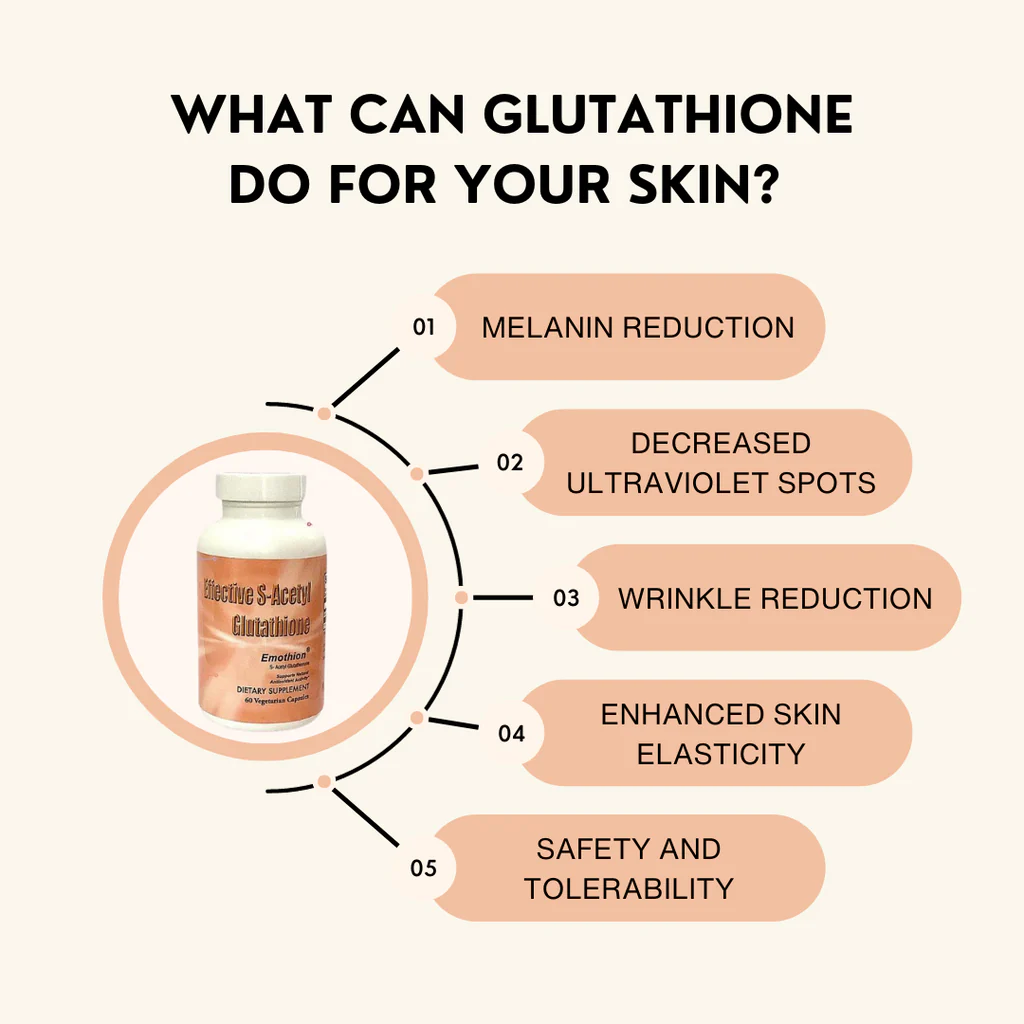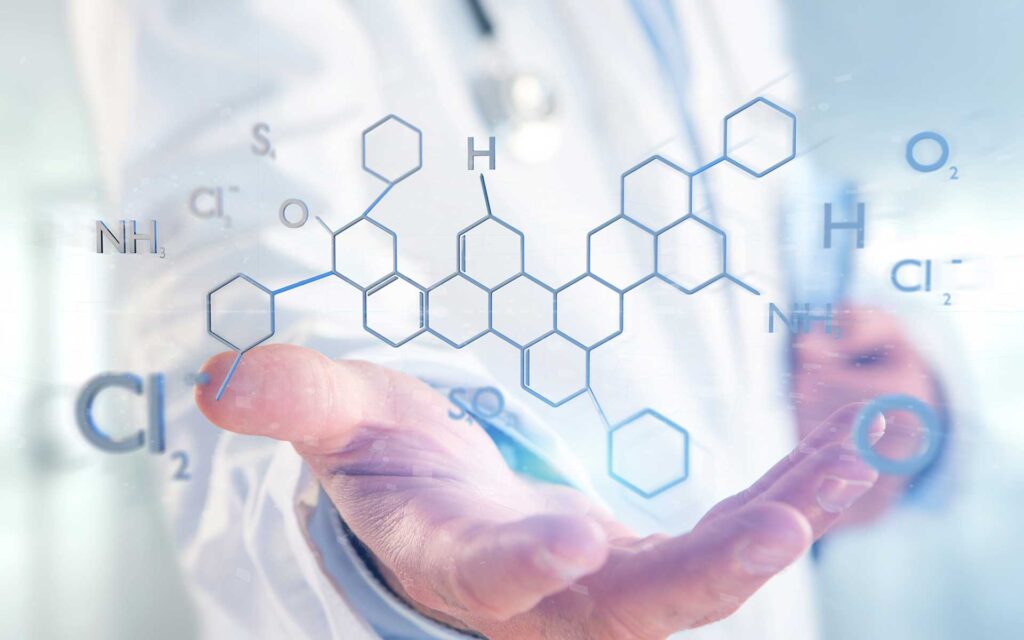Table of Contents
ToggleGlutathione Skin Whitening in 2025: The Truth, Benefits, Risks (Shocking Results)
Introduction:
The Obsession with Whitening in 2025
The quest for lighter, clearer, and more radiant skin is more important than ever in 2025. Fair skin has long been considered a sign of beauty, health, and status in South Asian, Southeast Asian, and African cultures. The beauty industry has responded by flooding the market with a wide range of whitening products and treatments. Glutathione is one of the names that stands out.
Once a little-known word in biochemistry books, Glutathione has now gained significant attention in dermatology clinics, skincare blogs, and social media reels. Glutathione is said to be a miracle molecule for getting brighter, glowing skin. People claim that it offers both antioxidant benefits and skin benefits. But what’s really going on with all the hype? Let’s examine it more closely, using science.

What is Glutathione?
Glutathione is an antioxidant that is found in almost every cell in the body. It is made up of three amino acids: glutamine, glycine, and cysteine. It is essential for keeping cells healthy, detoxifying, and fighting off infections.
Important Biological Functions:

- It neutralizes free radicals to prevent harm to cells.
- It assists the liver in eliminating toxins by attaching itself to them.
- Strengthens the body’s defenses against pathogens
- Recycles other antioxidants, like vitamins C and E
Glutathione is important for overall health, but it became famous in skin care for a different reason:
it may brighten the skin by changing how melanin is made.
How does glutathione work to lighten skin?
- The color of your skin, hair, and eyes comes from melanin. Tyrosinase speeds up a complex biochemical process that melanocytes, specialized skin cells, go through.
Glutathione stops this process in two important ways:
1. Stopping Tyrosinase Activity:
- Glutathione attaches to the active sites of tyrosinase, which stops it from turning tyrosine into melanin. This leads to a decrease in the production of melanin.
2. Change in the Type of Melanin:
There are two kinds of melanin:
- Eumelanin is a dark brown or black pigment.
- Pheomelanin: A pigment that is light yellow or reddish
Glutathione makes the skin review lighter time by making pheomelanin instead of eumelanin.
These processes make glutathione a unique ingredient in the skin-whitening industry. However, it is essential to acknowledge that outcomes differ based on the individual’s skin type, initial melanin levels, and the method of glutathione administration.
What does science say about glutathione?
Numerous clinical studies have examined the skin-lightening effects of glutathione, yielding diverse results:
- A 2012 study published in the Journal of Dermatologic Treatment found that participants who took 500 mg of oral glutathione each day for four weeks had a significant drop in their melanin levels.
- A 2018 double-blind, placebo-controlled study published in Clinical, Cosmetic and Investigative Dermatology demonstrated that sublingual glutathione effectively lightened skin tone with reduced side effects.
- A meta-analysis of 12 peer-reviewed studies in 2023 found that glutathione has a moderate but statistically significant effect on skin brightening, particularly in individuals with elevated baseline melanin levels.
Researchers are still debating how effective glutathione is because of differences in dosage, length of time, and delivery methods.

There are different forms of glutathione, each varying in effectiveness.
1. Glutathione in capsules and tablets taken by mouth
- The easiest and most convenient form
- Needs to be used every day for at least 8 to 12 weeks.
- Digestive enzyme breakdown may make it less effective.
- It is recommended to take it in conjunction with vitamin C to enhance its absorption by the body.
2. Glutathione in Liposomes
- It is encapsulated in phospholipids to keep it from being digested.
- More bioavailability than standard oral forms
- Although it is more costly, it yields faster and better results.
3. Glutathione under the tongue
- Given under the tongue
- Taken straight into the blood
- More powerful and better for your skin than tablets
4. Glutathione given through an IV
- Put right into the bloodstream.
- Results you can see the fastest (4–8 weeks)
- This is expensive and needs to be given in a medical setting.
- The FDA has not approved this product for skin whitening, and it carries risks such as infection and kidney strain.
5. Glutathione for the skin
- Used in creams, serums, and face masks
- It has the ability to reduce the visibility of dark spots and pigmentation on the skin’s surface.
- Only goes a little bit deeper into the skin layers
Safety, Side Effects, and Things to Avoid
Glutathione is mostly safe when used correctly. However, as with all supplements, it can pose a risk if not properly regulated.
Side Effects That Happen a Lot:
- A little bloating or stomach pain
- Rashes or itching on the skin
- Headaches or dizziness (rare)
Big Worries:
- Long-term use of IV glutathione can put a lot of stress on the kidneys and liver.
- This could potentially reduce the effectiveness of certain medications, such as chemotherapy drugs.
- Pregnant or breastfeeding women should not do it without a doctor’s supervision.
Status of Regulation:
- Oral glutathione is permitted as a dietary supplement.
- The FDA does NOT allow IV use for cosmetic purposes.
Facts and Myths About Glutathione
| Myth | Reality |
|---|---|
| It bleaches the skin instantly | It reduces melanin gradually over weeks or months |
| One injection makes skin fair permanently | Maintenance doses are required |
| All glutathione brands are equal | Many are counterfeit or ineffective |
| Men shouldn’t use glutathione | It works for all genders equally |
| It works the same on every skin type | Response varies by skin tone and genetics |
Ways to Naturally Increase Glutathione
Your body can also make more glutathione on its own by changing your diet and lifestyle.
- Foods That Make Glutathione Work Better:
- Onions and garlic (which have a lot of sulfur)
- Broccoli and spinach
- Asparagus, avocados, and turmeric
- Citrus fruits, which are high in vitamin C, include oranges, lemons, and grapefruits.
2. Important Nutrients:
- Vitamin C helps keep glutathione stable, which helps it grow back.
- Selenium helps make glutathione peroxidase.
- N-Acetyl Cysteine (NAC) is a direct precursor to glutathione.
3. Tips for Living:
- Work out often.
- Get 7 to 9 hours of sleep each night.
- Don’t drink or smoke.
- Cut down on your exposure to chemicals and pollutants.
Who Can Use Glutathione?
- Best Candidates:
- People who have melasma, hyperpigmentation, or sun damage
- People who want their skin to look smoother and brighter
- People who are detoxing or are under oxidative stress
2. Not Suggested For:
- Kids younger than 18
- Women who are pregnant or nursing
- People with liver or kidney problems who aren’t getting medical help
Advice from Experts on How to Use
- Dermatologists say to start with a low oral dose (500 mg/day) and only raise it if you need to.
- To get better results, always take Vitamin C (1000 mg/day).
- For faster results, some people may opt for sublingual or liposomal glutathione, but only a doctor should assist with IV therapy.
- For visible changes, you should use it for at least 8 to 12 weeks.
A Glutathione-Based Skincare Routine
- In the morning:
- Gentle cleanser
- Serum with vitamin C
- Day cream with glutathione
- Sunscreen with SPF 50
2. Night:
- Cleanser
- Serum with niacinamide
- Cream with Glutathione and Kojic Acid
- Moisturizer that goes deep
The Real Value of Glutathione: A Summary
Glutathione is still one of the best and most scientifically supported ways to safely and slowly lighten skin in 2025. It’s not a miracle that happens overnight, and it’s not a bleaching solution. Instead, it takes a slow, all-around approach to making your skin brighter and also helps your health in general.
Glutathione can serve as a valuable component of a modern skincare routine for individuals who are committed to regular use, appropriate dosage, and a healthy lifestyle.
FAQs : Related Glutathione
Q1. How long does it take for glutathione to make the skin lighter?
With regular use, especially in oral or sublingual form, you should see results within 8 to 12 weeks. The results may be different depending on your skin type, how much you take, and how you live.
Q2. Is it safe to take glutathione for a long time?
If taken in the right amounts, oral glutathione is safe to use for a long time. But IV use should be limited and done under medical supervision.
Q3. What type of glutathione works best for making skin lighter?
The best oral forms are liposomal and sublingual glutathione. IV gives results faster, but it also has more risks.
Q4. Is it possible for glutathione to permanently lighten skin?
No, it doesn’t make things permanently whiter. You need to take maintenance doses, and your skin may go back to its natural color if you stop using it.
Q5. What are the bad things that can happen when you use glutathione whitening?
Some mild side effects are bloating, headaches, skin rashes, and, in rare cases, strain on the kidneys or liver when using IV.
Q6. Is glutathione safe for men to use on their skin?
Yes, for sure. Glutathione works for everyone and is often used by men who want their skin to be brighter or more even.
Q7. Does the FDA approve glutathione for skin whitening?
The FDA does not give its stamp of approval to IV glutathione for skin whitening. Oral supplements are not medicines; they are sold as dietary aids.
Q8. What should I not do while taking glutathione?
Stay away from heavy toxins, alcohol, and smoking. These can lower glutathione levels and make it less effective at whitening and protecting against free radicals.
Q9. Is it okay to take glutathione and vitamin C together?
Yes, and you should. Vitamin C helps the body absorb glutathione better, which makes skin-brightening effects even better.
Q10. Who shouldn't take glutathione?
- You shouldn’t take glutathione if:
- Women who are pregnant or nursing
- Kids who are less than 18
- People who have serious liver or kidney disease (without a doctor’s advice)
Q11. Is it possible to use glutathione on the skin for the same effects?
Topical glutathione can help lighten dark spots and make the skin look better, but it doesn’t work as well for deep skin whitening as oral or IV forms.
Q12. Is there a way to naturally raise the level of glutathione in the body?
Yes. You can naturally raise your glutathione levels by eating foods like garlic, spinach, avocado, and citrus fruits, as well as taking supplements like NAC and selenium.
Q13. Does glutathione also help with acne and getting older?
Yes. It is a strong antioxidant that helps reduce inflammation, acne, and signs of aging like wrinkles and dullness.
Q14. When is the best time to take glutathione pills?
The best times to take it are in the morning on an empty stomach or before bed to get the most out of it.
Q15. Do I need a prescription to take glutathione?
You can buy both oral and topical forms without a prescription. However, a doctor must give and guide IV glutathione.